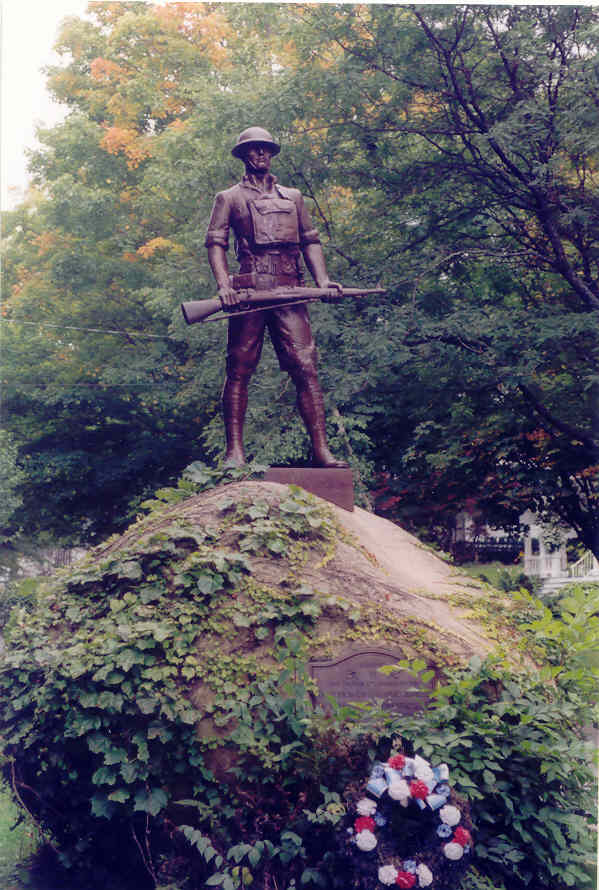My grandfather, Bill Coleman, served in France during the first World War. His sister, my great aunt Bess, wrote to him often during the war and later served on the committee to establish a memorial to the war dead. The list includes their cousin, Joe Coleman. She saved the program, which I have transcribed here.

Program of the
Unveiling and Dedication of the Cooperstown World War Memorial
Armstice Day,
November 11, 1931
The Memorial
Thirteen years have passed since that memorable Armistice
Day of November 11, 1918. Since that time there have been several attempts to
secure a World War Memorial all of which have proven unsuccessful. Finally the ladies of the American Legion
Auxiliary, Unit No. 579, pledged themselves to the task of properly
commemorating to posterity the deeds of those who served and the names of those
who made the supreme sacrifice in the World War and to that end asked the
Cooperstown Exchange Club and the Cooperstown Rotary Club to name a joint
Committee to select a site and a suitable form of Memorial.
Under
the able leadership of Hon. Walter Watson Stokes, who became the Chairman of
this joint committee, the site was secured, the form of Memorial agreed upon by
the committee, adopted by the American Legion Auxiliary, Unit No. 579, and the
campaign for the necessary funds instituted, all of which culminated in the
splendid Memorial we are now here to dedicate.
The
Committee here wishes to extend its appreciation to those whose services made
this Memorial an actuality.
The
designer and sculptor of the bronze figure is John Horrigan, Sr., of Boston,
Mass. The Studio in which the statue
and markers were modeled and cast is T. F. McGann & Sons Co., Boston,
Mass. The beautiful granite boulder
upon which the bronze figure stands is the gift of Mr. William Lighthall of
Starkville, New York. The moving and
transporting of the huge boulder from its location near Starkville, Herkimer
County, N.Y. , to Cooperstown presented a very difficult engineering problem which was successfully completed by
Hans H. Frey, as principal contractor and the sub-contractors Bart J. Ruddy,
Inc., and Utica Trucking and Cartage Co., All of Utica, N.Y. The markers were
placed by Everett A. Potter and Peter Jones of Cooperstown. Miss Elizabeth Patterson of Cooperstown,
suggested the inscription on the tablet on the front of the Memorial. Alfred R. Cobbett and Ernest F. Tyler of
Cooperstown, supervised the architectural details regarding the general design
and the placing of the Memorial.
And
last but not least the Committee is deeply grateful to those loyal and
patriotic citizens of Cooperstown and vicinity whose suggestions, advice, and
generous contributions have made the Memorial possible.
In Memoriam
|
Gold Star Mothers
|
Harry J. Andrews
|
Mrs. Viania O’Dell (deceased)
|
F. Clifford Bliss
|
Mrs. Frank Bliss
|
Robert G. Cobbett
|
Mrs. William Cobbett (deceased)
|
Joseph A. Coleman
|
Mrs Charles Coleman
|
James Fenimore Cooper, Jr.
|
Mrs. James
Fenimore Cooper
|
Vinton A. Dearing
|
Mrs. Mary H. Dearing
|
Foster Eggleston
|
Mrs. George Eggleston (deceased)
|
James Franklin Hayne
|
Mrs. James Hayne
|
Charles E. Hecox
|
Mrs. Kendrick Hecox
|
Walter Herrick
|
Mrs. James J. Shartz
|
Charles N. Hopkins
|
Mrs. Charles L. Hopkins
|
Leo A. Leach
|
Mrs. L. Leach (deceased)
|
Stephen J. Johnson
|
Mrs. Stephen Johnson
|
Charles Mc Graw
|
Mrs. Cora McGraw
|
Lewis N Mallory
|
Mrs. William Mallory
|
H. Lynn Marble
|
Mrs. James L. Marble (deceased)
|
Albert S. Peet
|
Mrs. Fenimore C. Peet (deceased)
|
George T. Record
|
Mrs. Chauncey A. Record
|
Henry Reed
|
Mrs. Hiram Reed (deceased)
|
Ralph R. Rexford
|
Mrs. L. Rexford (deceased)
|
Lewis W. Ross
|
Mrs. Fred Armstrong
|
Albert L. Seeber
|
Mrs. George Seeber
(deceased)
|
Walter A. Seeger
|
Mrs. Lester C. Seeger (deceased)
|
Clark F. Simmons
|
Mrs. Frank Simmons
|
John W. Stiles
|
Mrs. James Stiles
|
Fred L. Stilson
|
Mrs. M.D. Stilson
|
Harry A. Winn
|
Mrs. Abram Winn
|
Committee
Walter Watson
Stokes, Chairman
Berton G. Johnson,
Vice Chairman
Alfred Rcobbett,
Treasurer
Mrs. Fletcher A
Blanchard, Secretary
Mrs. Floyd J. Atwell Miss ElizabethG. Patterson
Fletcher A. Blanchard Mrs.
Alfred J. Peevers
Harold D. Carpenter Adrian
A. Pierson
Mrs. Alfred R. Cobbett Dr. Leroy Pitcher
Miss Elizabeth Coleman Benjamin Reisman
Newton E.D. Gilmore Mrs. Frank Simmons
Berton G. Johnson ` William
C. Smalley
Mrs. Berton G. Johnson Mrs.
James Stiles
Joseph P. Leary Clermonte G. Tennant
Moses E. Lippitt Orange L. Van Horne
Mrs. A. John Wedderspoon
Program
Invocation The
Rev. Gordon L. Kidd
Huggick-Purcell-Shepherd
Post, American Legion, Richfield Springs Singing “America”
Presentation of Monument Rowan D. Spraker,
President of
the Village
Acceptance of Monument Alfred R. Cobbett
Clark
F. Simmons Post No. 579,
American Legion, Cooperstown
Unveiling under direction of A. Leo Stevens, formerly chief
instructor in Aeronautics, U.S. Army.
Dedication The
Hon. Clermonte G. Tennant, Cooperstown
Singing National
Anthem
Salute to the Dead
Taps
Benediction
Program by courtesy of the Freeman’s Journal Co.
Photo from The Doughboy Center, unattributed


